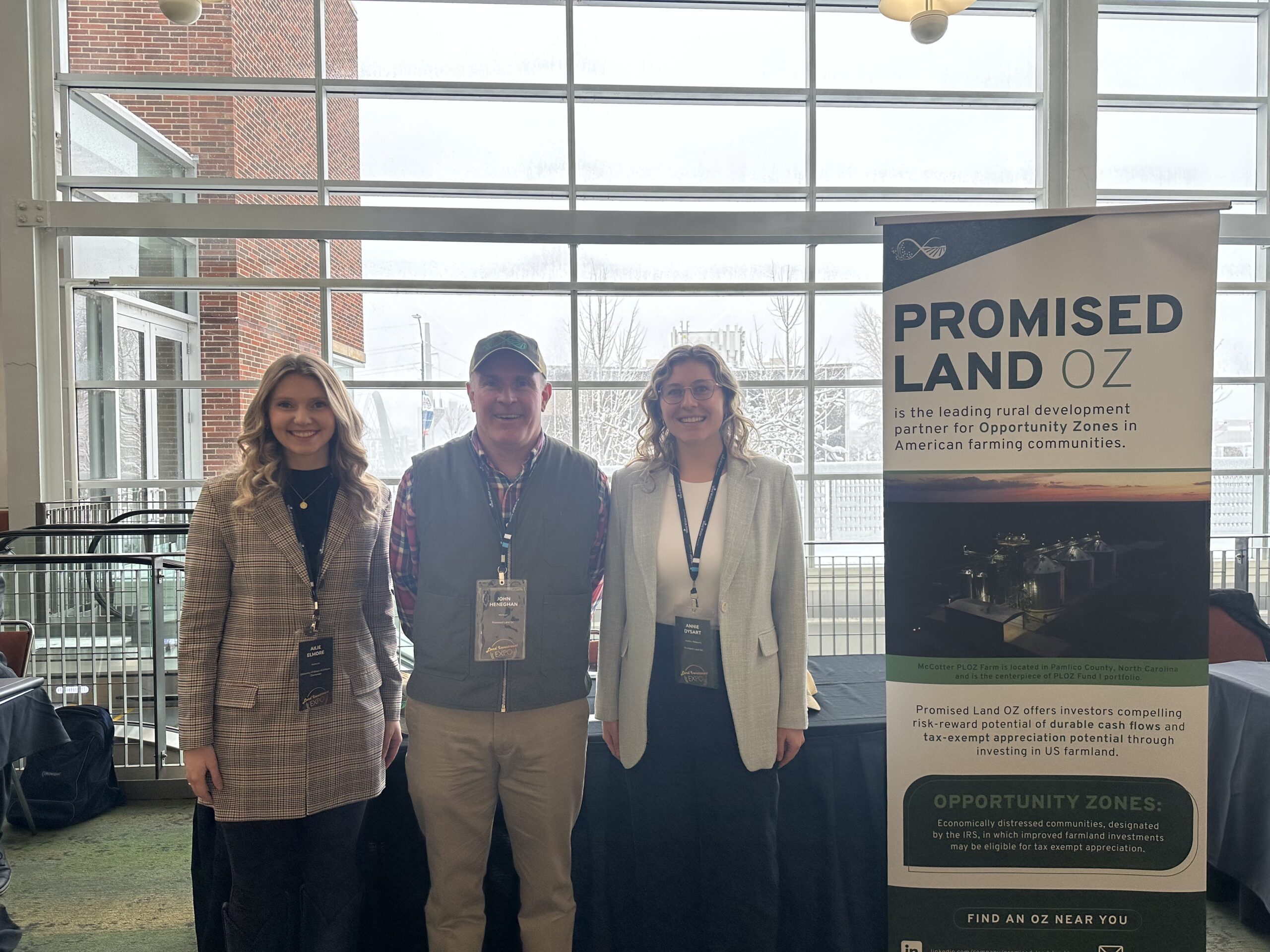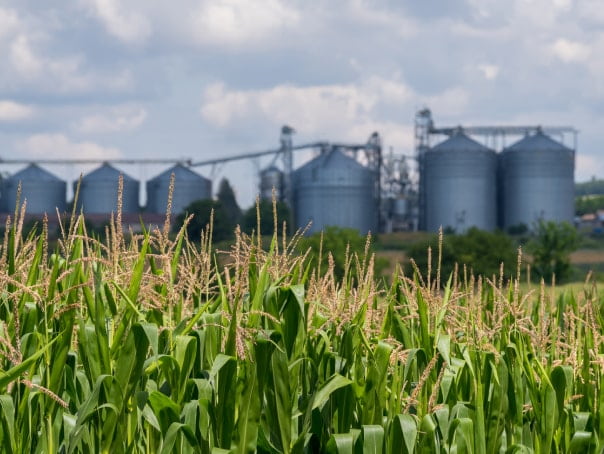The Promised Land team had the opportunity to attend the 2024 Land Investment Expo in January where we listened to a series of enriching conversations about the current geopolitical climate, legislative updates, and the future of agriculture. One keynote session that was of particular interest to the Promised Land Team was Dr. David Muth’s discussion titled, The Opportunities for US Farmland in a Net Zero World. Dr. Muth, Managing Director of Capital Markets at Peoples Company, discussed agricultural land’s central role within renewable energy transition and how best to monetize these real options. At Promised Land, we foresee a rich opportunity set under development in organic farming, climate-smart ag, conservation practices, and renewable energy. These evolving ecosystem services generally strive to minimize the environmental impact of farming through more eco-friendly practices such as reduced water usage through appropriate tillage, irrigation, and precision grading. We see continued interest among investors and stakeholders in these environmental, social, and governance (ESG) friendly investments and farming practices. To this end, we thought Dr. Muth’s perspectives on the future of energy transition and agriculture were worth sharing.
“The beginning of the end of fossil fuels.” – Simon Stiell, Executive Secretary, United Nations Framework Convention on Climate Change.

“The beginning of the end of fossil fuels.” – Simon Stiell, Executive Secretary, UNFCCC (United Nations Framework Convention on Climate Change). Dr. Muth began his presentation with this quote from the Conference of the Parties (COP) Meeting through UNFCCC where Mr. Stiell gave an overview of the current status of carbon emissions and opportunities for the future. Globally, we consume 137K terawatt-hours of fossil fuels annually, resulting in total global emissions of 58.2 billion tons of CO2 (carbon dioxide). One terwatt hour will fully power 70K homes for a year. Currently, nations across the world are spending a total of $1.7 trillion towards the transition from traditional fossil fuel sources to renewable energy sources. Dr. Muth believes that spending needs to be closer to $4.3 trillion if the world wants to hit its net zero goals. Put simply, net zero means cutting carbon emissions to a small amount of residual emissions that can be absorbed and durably stored by nature and other carbon dioxide removal measures, leaving zero in the atmosphere. China leads the world in energy transition spending with the United States and Germany coming in second and third. Interestingly enough, while China is investing the most in the renewable energy space, they also are building coal-fired electricity plants at a staggering rate. This contradiction suggests that China’s interests aren’t just investing in sustainable energy, but they are investing in energy capacity, period. (Watt a concept!)
Dr. Muth divided his energy transition presentation into four buckets: wind turbines, solar, renewable fuels, and carbon storage. These key pieces to the energy transition are known to have the largest potential effect on agriculture as abundant land plays a foundational role in the broad deployment of these technologies.. If you drive across the great plains of the Midwest, you will likely see tall wind turbines spread across the countryside amongst the farm fields and ranch land. Since the Land Investment Expo takes place in Iowa, many of the examples used in Dr. Muth’s analysis are related to Iowa. Dr. Muth also discussed how energy transition could affect the entire country. Nationwide there are 73,352 active turbines with 6,293, or 9%, of those spinning in the state of Iowa. If wind energy was expanded to meet the nation’s demand for electricity in combination with other renewable sources, Iowa would need around 47,900 to meet this demand, or almost 8 times the current resource.
The other common renewable energy source popping up across farm fields and commercial and residential roofs is solar panels. Nowadays, it is impossible to make a trip to Costco without someone trying to sell you a pair of solar panels for your home. Currently, there are 3.5 million acres of solar panels across the United States but that is not enough to meet our nation’s net zero goals. Dr. Muth projected that solar acres would need to grow by 3 to 4 times if the U.S. wanted to meet its energy transition goals. There has been considerable debate on whether to use high-quality farming acres for food or energy purposes when it comes to solar panels. While farmers can still operate around wind turbines, covering a field in solar means that farming is no longer viable. The Midwest is home to some of the most productive soil in the world and Dr. Muth projects many of the solar panels would likely not be placed in Iowa and other states in the Corn Belt. He expects solar farms to be built in the Southwest and Southeastern states where there are long days of sunshine and less productive soils.
Dr. Muth next transitioned his talk to renewable diesel which has been all the buzz in agricultural markets but it comes with some valid concerns. Soybeans can be used for a variety of food, fiber, and feed products. Recent advancements and legislative pushes in soybean biodiesel and sustainable aviation fuel have brought about new opportunities in the space. Currently, the United States has 22.75 billion gallons of capacity for renewable diesel and would need to double that number to meet the expected future demand for renewable diesel. That also means that U.S. farmers would need to produce 24 billion bushels of soybeans. Currently, the United States produces around 4.5 billion bushels of soybeans and while renewable show promise, people are still hesitant to fully move away from traditional petroleum-based diesel due to costs and infrastructure challenges. The costs of producing soybean biodiesel are substantially higher due to the refinery process and there are also concerns that it isn’t all that sustainable. Even though it comes from plants, soybean biodiesel produces more emissions than traditional oil-based fuels. The other concern with soybean biodiesel is that wide expansion would end up hurting the consumer on food prices. Soybeans and soybean oil are key ingredients in a majority of processed foods that you would find in the grocery store. Adding to the competition demand from soybean biodiesel could disrupt our food supply which is known for being secure and relatively cheap. While the space has promise, it is going to need continued research and advancements before wide adoption.
The final portion of Dr. Muth’s presentation centered around finding a place to sequester the carbon so that it wasn’t harmful to the environment. Soil provides us with many things and is an essential ingredient in agricultural production but it can also be used for carbon storage. Carbon can effectively be pumped and stored underground just like oil and natural gas have been stored for millions of years on Earth. The state of Illinois has been at the forefront of the discussion around carbon storage as its rich black soil makes it ideal for storing carbon. If the United States were to store all of its carbon emissions underground it would cover 27 feet of depth in the states of Texas, New Mexico, Arizona, California, Nevada, Utah, and part of Colorado just as a frame of reference. There are several environmental and safety concerns over carbon storage as it can be very dangerous if the carbon leaks. A recent push to develop a carbon storage pipeline through Iowa has been met with concern over the potential safety concerns and impact on the land itself from digging and equipment compacting the soil. The pipeline would carry carbon emissions from ethanol plants which are known to be substantial emitters of carbon. While there could be a large opportunity for landowners to earn additional income sources from carbon storage, there still needs to be more research on its effects on the surrounding communities.
The closing punchline to Dr. Muth’s presentation was that a significant requirement to meet the U.S.’s “net zero” goals will require large swaths of land. With several hundreds of millions of acres of U.S. land presently devoted to agriculture, farmland is a natural target for the deployment of these technologies. There will always be concerns over the use of land for food or energy but when examining the monetary effect of the possible energy transition, the potential economic benefits of rural farming communities could be quite large. Producers and landowners alike stand to benefit substantially from the opportunities at hand. Dr. Muth estimates a combined $400 billion effect on farmland values and agricultural income. He put forth a staggering estimate that land values in the Midwest, where much of the energy transition will be centered, could triple or quadruple in the next 25 years. However, these projections are not that farfetched. A compound annual growth rate (CAGR) for a farm that triples in value over 25 years is 4.5% which is in line with our estimate of the 10-year appreciation potential of farmland computed as 2.0% spread over consumer price inflation (CPI). All items CPI rose 3.4% in the twelve months ended February 2024 while the 10-year TIPs/Treasury breakeven is presently 2.4%. The CAGR for a farm that quadruples in value over 25 years is 5.7%, also plausible in an ongoing era of money printing.
Promised Land is dedicated to staying on top of these energy transition developments and their value creation potential for our landowner investors. We will continue to look for properties that may have wind or solar development opportunities as well as ways to capitalize on stranded energy and/or energy storage potential. We hope to be at the forefront of this evolving landscape and help usher in the new promised land of abundant, cheap, sustainable energy while revitalizing rural American farming communities located in Opportunity Zones.

(Image of Promised Land’s Broadland PLOZ Farm in downstate Illinois with its 3 wind turbines)











